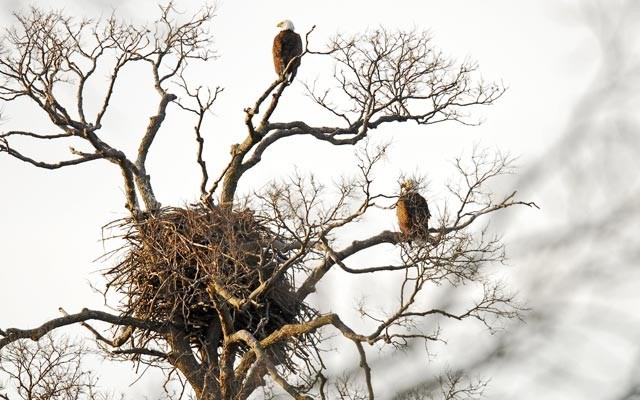Near the end of March, 2013, with the cattails lying flat and brown in forlorn mats, a handful of folks huddled on a boardwalk that zigzags into Cootes Paradise Marsh and trained their spotting scopes on the bald eagle nest crowning a sturdy white pine to the west. Someone thought they saw the small grey head of a hatchling. When further scrutiny confirmed two eaglets in the nest, a round of jubilant fist-pumping ensued. What might constitute a serendipitous sighting elsewhere—or a shoulder shrug on the eagle-addled West Coast — was cause for bona fide celebration.
The eagle-envy context was significant: while wilderness and wildlife still very much define B.C., and Whistlerites can see bald eagles almost any day they choose, these were the first to nest successfully along the Canadian shores of Lake Ontario in over 50 years. More improbably, the birds had done so in the most unlikely of places: the city of Hamilton.
Hamilton. Steeltown. The Hammer. Longtime poster-child for the industrial hubris and chemical carelessness that vanquished the once-abundant raptors from much of their eastern range to begin with. Although most of these offences have been regulated into history, a mind's eye panorama of belching smokestacks and discharging pipes still engenders a knee-jerk ranking of the city's harbour with a tar-sands settling pond. And while a bald eagle nest here was unheralded, it was most certainly deserved — a semaphore for the nascent re-wilding of an environment once declared all but dead.
Like most high-value sightings in the birding community, this one spread like wildfire. There were days when a scope-wielding phalanx of Tilley hats crowded the boardwalk to its very edges. It was, according to one witness, "a circus." For Cootes Paradise, one of four nature sanctuaries comprising the city's historic Royal Botanical Gardens, that circus was a now-realized mission statement, emblematic of a decade of concerted environmental rehabilitation. For Hamilton native Tys Theysmeyer, Head of Natural Lands at RBG, it was also a personal victory in a years long war against habitat degradation, pollution, and invasive fish and plants.
"To date we've achieved a marsh that's producing fish, frogs, mollusks and plants the way it should," he says. "When you build back basic bottom pieces like lower-food-chain fish, you begin to attract upper pieces like eagles."
You need more than snacks, however, to appease an apex avian predator. Large territories are required, with big trees to support nests that can weigh a metric ton—neither easy to come by in an urbanized landscape. Space, in fact, was the puzzle piece fortuitously already in place to facilitate eagles once the environment improved: since its inception in 1927, RBG had grown to 300 cultivated acres and 2,500 acres of natural lands.
"Eagles were mythical when I was kid," says Tys. "You couldn't even imagine seeing one. I saw the first ones here in 2004 — two juveniles hacking at a carp carcass — and thought 'Eagles? That's incredible!' The first resident eagle was identified in 2007 and then, all of a sudden, out of nowhere there's a pair."
In 2009 those birds took an unsuccessful crack at nesting. The spot they picked, however, was too isolated to manage the inevitable tsunami of visitors. The solution was to send climbers up the present tree to build a loose frame of branches resembling the beginnings of a nest. "The eagles went, 'Yup, we'll take that,'" recalls Tys. "Two years ago they occupied it and nothing happened. I wondered whether we still had contaminant issues — I mean, it is Hamilton. But this year they were back so we went out to the boardwalk in March when we calculated that the incubation time was probably up and... there were the eaglets."
Elated but cautious, they decided that the best way to manage the news was to make a show of it with proper publicity and signage and hope anyone who tried to skirt the designated viewing areas would be peer regulated (they were). "Suddenly people were referring to Cootes as a 'nature reserve.' After 50 years of disaster and chaos here it was suddenly all new again."
If it took eagles to bring the Royal Botanical Gardens back to Hamiltonians' attention, then the Cootes to Escarpment EcoPark System initiative currently underway to link wild spaces across the region will help the public understand why this unique area was a nature reserve to begin with, and that emblems like eagles are only the most obvious manifestation of a healing ecosystem. "The eagle story has been remarkable, amazing and a bit nerve-wracking," Tys says. "But driving into work one day last summer I realized something else. Now that there's more quality territory, Cootes has become a staging area for about 30,000 redwing blackbirds that fly out to surrounding farm fields every morning to feed on bugs and then return here every night — that's exciting, too."
Re-wilding isn't a new or complicated idea, but sometimes you need eagle eyes to see the bigger picture.




